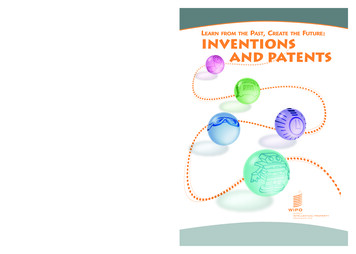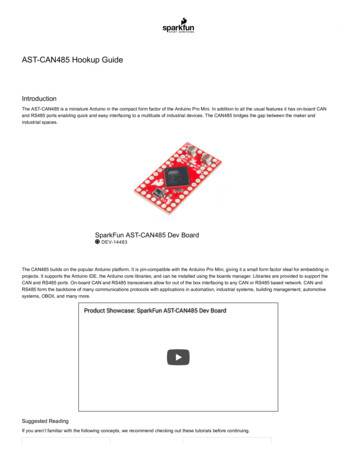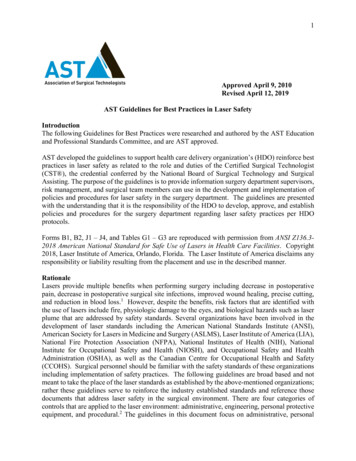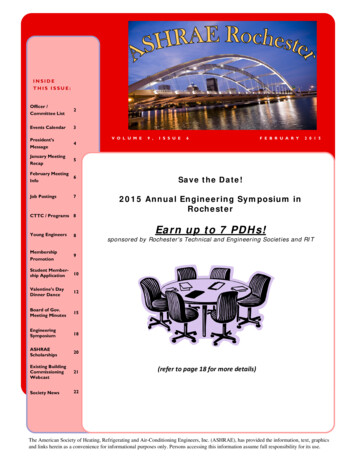
Transcription
925E-CaP-2010 Layout 1 23.09.10 10:47 Page1LEARNFor more information contact WIPO at www.wipo.intWorld Intellectual Property Organization34, chemin des ColombettesP.O. Box 18CH-1211 Geneva 20SwitzerlandTelephone: 41 22 338 91 11Fax: 41 22 733 54 28WIPO Publication No. 925ESeptember 2010 editionISBN 978-92-805-1431-5FROM THEPAST, CREATETHEFUTURE:Inventionsand Patents
925E-CaP-2010 Layout 1 23.09.10 10:47 Page2Disclaimer: The main purpose of this publication is to provide basic information, it isnot meant as a substitute for professional legal advice. Mention of names of firms andorganizations and their websites does not imply the endorsement of WIPO. World Intellectual Property Organization, 2007Text: Maria de IcazaGraphic Design: Sheyda Navab
LEARNFROM THEPAST, CREATETHEFUTURE:Inventionsand Patents
ContentsPREFACEINVENTIONSWhat are inventions?How do we know when inventions were first invented?Game – Inventions of Ancient CivilizationsHow are inventions invented?Inventions improve our livesGame – Inventor Match-makerPATENTSWhat are patents?Why are patents important?When were patents invented?Modern patent lawsHow do inventors obtain patents?When should an invention be patented?What happens if an invention is not patented?Are patented inventions protected worldwide?Can there be different inventors for the same invention?Patents are a wonderful source of informationThe PCT GazetteGame – PCT Detective2
BECOME AN INVENTORIdentify a need or a problemResearchExperiment and keep an open mindApply for a patentEnter a competitionCommercialize your inventionGame – Patent JourneyFINAL THOUGHTSINVENTION JOURNALANSWERS TO GAMESGLOSSARYFURTHER READINGSELECTED BIBLIOGRAPHYOnline SourcesNOTE TO TEACHERS3
PREFACE“Inventions and Patents” is the first of WIPO’s Learn from the past,create the future series of publications aimed at young students.This series was launched in recognition of the importance of children andyoung adults as the creators of our future.The first two parts of this publication are designed toprovide basic information about inventions and patents.The aim is to communicate the importance ofinventors, their inventions and patents through games,thought provoking exercises and concrete examples.Part three provides a roadmap for invention andencourages young students to invent and patenttheir creations.Winners of a WIPO gold medalat the 2003 “To be an Inventor”challenge in Tayside, Scotland.These Netherlee Primary Schoolstudents invented a “Floodbuster”device to prevent the bath fromoverflowing when unattended.4At the end of this publication are detailed answersto the games, an inventor’s glossary and an inventionjournal to track the young inventor’s work.
INVENTIONSWhat are inventions?Generally speaking, an invention is a new product or process that solves atechnical problem. This is different from a discovery, which is somethingthat already existed but had not been found.Consider, for example, the telescope and the mountains ofthe moon. The telescope is an invention that was created in1608 when Hans Lipperhey, a Dutch eyeglass maker,combined convex and concave glasses at either end of atube. It was only with the invention of the telescope thathumans (Galileo Galilei to be precise) were able to look farenough into the sky to see the mountains of the moon.Galileo didn’t invent these mountains, he discovered them with the help of an invention.Just as inventions can lead to discoveries, discoveries can sometimes alsolead to inventions. For example, Benjamin Franklin’s discovery of theelectrical effects of lightning led him to invent the lightning rod around1752. This invention is still in use today and has madebuildings much safer places during thunderstorms.From the beginning of time, humans everywhere havebeen inventing. In fact, most of what is around younow was invented by someone in the past. We havegrown so used to these things, however, that weoften don’t think of them as inventions.Think about the alphabet that we are using to communicateright now. The ink and paper that these words are written on.The clothes you are wearing. The chair you are sitting on. All of these areinventions and there is a person, a human mind, behind each of them.5
Think about it:What other inventions have led to discoveries?What other discoveries have led to inventions?How many inventions can you identify in this scene?What would your world be like without inventions?Inventions are essential to our everyday life and yet most people knowvery little about their origins.6
How do we know when inventions were first invented?Many inventions were invented thousands of years ago so it can bedifficult to know their exact origins. Sometimes scientists discover amodel of an early invention and from this model they can accurately tellus how old it is and where it came from. However, there is always thepossibility that in the future other scientists will discover an even oldermodel of the same invention in a different part of the world. In fact,we are forever discovering the history of ancient inventions.An example of this is the invention of pottery. For many years archeologistsbelieved that pottery was first invented in the Near East(around modern Iran) where they had found pots datingback to 9,000 BC. In the 1960s, however, older potsfrom 10,000 BC were found on Honshu Island, Japan.There is always a possibility that in the futurearcheologists will find even older pots somewhere else.Sometimes archeologists can only find pictures orwritten references of an ancient invention. Though theyare proof that the invention existed, texts and picturescan make it difficult to determine when, where and by whomthe invention was created.This is the case of the compass. Scholars have found a clear descriptionof a sinan (navigational device) in a Chinese text dating back more thantwo thousand years. While no actual models of this invention have beenfound to date, the description in thisancient text leads us to believe that thisancient form of compass was invented asSinan model by Susan Silvermancourtesy of Smith College, History ofScience and Technology Program7
early as 2400 years ago in China, and it took more than 1000 years for itto be introduced to the West (via Arab traders) in the 13th Century AD.When scientists are very lucky, they find texts that not only mention pastinventions but also describe them in great detail and even reveal the nameof the inventor and the approximate date of the invention. In these caseswe have concrete proof of when, where and by whom the invention wascreated and we can give proper credit to the inventor.This is how we know, for example, about the Greco-Egyptianengineer Heron of Alexandria who created countless machines inthe late first century AD. Also known as mekanicos (machineman), Heron was famous in his time for his numerous inventions,especially his automatic machines that included a steamengine, a coin-operated slot machine and automatic doors.Sometimes, different ancient civilizations independentlyinvented very similar items. For example, almost everyancient civilization invented mirrors. Ancient mirrorsmade of polished volcanic glass (obsidian) havebeen found in Turkey and Mesoamerica, whilepolished bronze or copper mirrors were madeHeron’s steamengine model byKaren Fishercourtesy ofSmith College,History ofScience andTechnologyProgramby the inhabitants of ancient Egypt, Mesopotamia, China,Greece, Rome, and the Indus valley.In modern times, patents help us to determine when, whereand by whom an invention was invented. The second chapter inthis book will give you more information about the use of patents.8
Game* – Inventions of Ancient CivilizationsSome inventions from thousands of years ago are still in use today. Do youknow the origins of these ancient inventions?RussiaChinaMexicoEgyptMAP: CL I PA R TAlaskaIraqAustraliaKiteChocolate*See page 55 for answersLighthouseWheelBoomerangSnow GogglesSkis9
How are inventions invented?Necessity is the mother of invention.-famous proverbIn order to invent, inventors first identify a need or problem. They thenthink of a creative way to solve the problem, and work hard to make thatsolution possible.Here are a few examples of things that have inspired inventors to invent.1) Needing something that is not available in the market:Invention Profile: Adding MachineBlaise Pascal was a well-known French philosopher, mathematician andphysicist but he was also a young inventor. His father was a tax collectorwho spent long hours calculating by hand how much tax he had to collect.In 1642, at the age of 19, Pascal invented a mechanical adding machinewhich his father could use to calculatethe taxes more quickly and accurately.Pascal’s machine was called the Pascaline.10
2) Wanting to help somebody:Invention Profile: Stop-motion Device for Textile LoomsIn 1850, at the age of 12, Margaret Knight witnessed a serious accidentat a textile mill. Concerned for the safety of the mill’s workers, she inventeda stop-motion device to quickly stop the powered textile looms in casesomething went wrong. Her invention was put to use at many mills whereit increased the safety of all mill workers. This was only the first ofMargaret’s many inventions. She was grantedmore than 25 patents in her lifetime, includingone for a flat-bottomed paper bag still usedin some stores today.3) Combining two or more products to produce a new and better product:Think about it:How many inventions can you uncover by combiningtwo of the items listed WheelsShoesRadio11
4) Applying a better understanding of nature:Invention Profile – VELCRO One day in 1941, Swiss engineer George de Maestral took his dog for awalk in the Swiss Mountains. By the time they returned home, his clothesand his dog were covered with cocklebur seeds. Curious about what hadmade these seeds stick to fabric, George decided to examine them undera microscope. He found that the seeds had tiny hooks that had stuck tothe loops of the fabric.George decided to use the same principle of tiny hooks and loops todevelop a new and better fastener than the zippers available at that time.After many experiments he developed two nylon tapes (one covered withtiny loops and the other with tiny hooks) which stuck together whenpressed. The VELCRO brand fastener waspatented in 1951 and is now used in manyproducts including shoes, jackets and bags.Colorized scanning electron micrographicimage of joined VELCRO . Dee Breger,Drexel University12
5) Combining traditional knowledge with modern scientific concepts:Invention Profile – Pot-in-Pot Cooling SystemNorthern Nigeria is a hot, semi-desert rural area where many people haveno electricity. Most people grow and sell their own crops, yet keepingfruits and vegetables fresh in this type of climate is a real challenge.Without refrigeration, most fresh food rots within a couple of days.Throwing away spoiled crops means lost income for poor families. Eatingthe rotting crops causes serious health problems.Local teacher Mohammed Bah Abba was concerned about this problem anddecided to find a solution for it. As a boy born into a family of clay potmakers, Mohammed knew that these traditional clay pots retained watereven when dry. In 1995 he combined this traditional knowledge with hisunderstanding of biology, chemistry and geology to design a pot-in-potcooling system that acts as a “desert refrigerator”.Mohammed’s cooling system is made up of a small pot placed inside alarger pot with wet sand filling the space between the two clay pots.The fruit and vegetables are kept in the smaller pot, covered with a dampcloth and left in a dry, ventilated place. When water from the sandevaporates, it causes the temperature in the pots to go down severaldegrees so the food in the smaller pot is always cool. With the pot-in-potsystem food stays fresh much longer. For example, aubergine can stayfresh for 27 days instead of the usual three days.Mohammed’s system has improved the lives ofthousands of people, which is why in 2000 he wonthe prestigious Rolex Award for Enterprise.13Courtesy of The Rolex Awards forEnterprise
6) Improving past inventions:Not every invention has to provide a completely new solution. Some verygood inventions are improvements on previous solutions.In the short history of the home computer we have seen many improvementsin the way data are externally stored. Small memory sticks can now storemore information than the older, bigger and more fragile floppies. Can youCourtesy of Sonyimagine the next improvement for external data storage?2000sMemory sticks1990sCD-Roms/DVDs1980sFloppy disks142010sNext improvement
Inventions improve our livesInventions improve our lives in many ways. They make our tasks easier,entertain us, improve our knowledge of the world, and even save lives.Think about it:Make a list of inventions that makeyour life easier, better or simply more fun.Below are a few examples to get you started.Inventions that make our lives easier:CarsInventions that increase our knowledge of the world:MicroscopesInventions that entertain us:TelevisionsInventions that save lives:Fire extinguishers15
Game* – Inventor Match-makerWe owe our modern way of life to all the inventors who came before usand yet most people cannot name more than one or two of them. This isquite surprising when you consider that the names of many inventors arehidden in the names of inventions we use everyday.Can you match the inventions below with their inventors?Gabriel Fahrenheitcoffee-makingmethod and filterAlessandro Voltabread slices with fillingof meat, cheese, etc.George Eastmanwriting systemfor the blindLouis Braillecamerawith roll filmLevi StraussEarl of SandwichMelitta Bentzbatteryblue jeansmercury thermometerand temperature scale*See page 56 for answers16
Think about it:Can you find other inventors whose namesare related to their inventions?Here are a couple of examples to get you started:Diesel engines – invented in 1892 by German engineer Rudolf DieselPasteurization process – invented by French chemist Louis Pasteur in 1856Inventions are so important to all of us that we should encourage talentedinventors to keep inventing. One way to encourage inventors is by preventingpeople from stealing their inventions. In the next chapter we will see howpatents help to achieve this.17
PATENTSWhat are patents?A patent is an official document given to an inventor by a government.This document generally gives inventors the right to stop anyone else fromcopying, using, distributing or selling the invention without their permission.Patents are a part of Intellectual Property, which is a legal way toprotect all creations of the human mind. Intellectual Property is dividedinto Industrial Property and Copyright.Intellectual PropertyIndustrial Property:Patents protect inventionsIndustrial designs protect the designsof productsTrademarks protect distinctive signsCopyright:protects literary and artistic worksWhy are patents important?Inventions are the result of hard work. It may only take a moment ofinspiration to think of a good idea but it takes a lot of research andexperimentation to turn the idea into a useful and working invention.Inventors deserve a reward for the amount of time they spenddeveloping their ideas. They also need the security of knowing that ifthey share the invention with the rest of the world, nobody will steal it,use it or copy it without their permission.Patents provide rewards and protection for inventors but they alsobenefit society. In return for patent protection, inventors agree to revealall the technical information about their invention. This information isavailable to everyone and has enough details so anyone with basic knowledge18
of the invention’s field can reproduce the invention. In this way, patents helpto spread new knowledge. This new knowledge can in turn help others to solvedifferent problems, or to make further advances in science and technology.Inventor Profile – Leonardo Da VinciLeonardo Da Vinci was a famous painter and sculptor but also a greatinventor. He had an excellent understanding of how machines worked andinvented many things during his lifetime. His inventions included parachutes,flying devices, diving gear and many other machines.Before patents existed, some inventors kept their inventions secret forfear that they would be stolen or copied. Some historians believe thatDa Vinci wrote the notes on his experiments backwards (“mirror writing”)to make it harder for other people to read and copy them.It took hundreds of years for scholars to find and decipher some ofDa Vinci’s notebooks. Recently, some people have started making models ofinventions that Da Vinci described and drew in his notebooks more than500 years ago. For example, in 2000 Katarina Ollikanen from Swedenbuilt a rigid pyramidal parachute based on Da Vinci’s drawings from 1485.She used only tools that would have been available in Da Vinci’s day.Her English skydiver boyfriend, Adrian Nicholas, used this parachute to makea successful 3,000 meter descent in South Africa, proving that Da Vinci’sparachute invention worked.The first non-Da Vinci, modern parachute was inventedin 1797 by André Jacques Garnerin, more than300 years after Da Vinci sketched his version in hisnotebooks. Knowing this, we cannot help but wonderhow history might have been different if Da Vinci hadshared all his inventions with the rest of the world.19
Think about it:Think of three items that you use everyday. How differentwould your life be if the inventors of these items had not sharedtheir inventions with the rest of the world?When were patents invented?In the 15th Century, Venice was a very important center for art, science,trade and commerce. Many inventors lived in Venice at the time andin 1474 the government invented the first law to protect the rights ofinventors.This Venetian law allowed any inventor of a workable invention to registerit in a state office. With this registration, the inventor would have certainrights over his invention so nobody would be able to copy or sell it withoutthe inventor’s permission. This protection was limited to 20 years, afterwhich time the invention could be copied or sold by anyone. In return for thisprotection, the inventor had to use the invention for the benefit of the state.After Venice, other states began to encourageand protect their inventors with similar laws,and nowadays almost all countries have theirown modern patent laws.20
Modern patent lawsModern patent laws protect the inventor for a specific period of time(usually 20 years) during which, in general, it is illegal for anyone else tocopy, use, distribute or sell the invention without the approval of theinventor. In return for this protection, inventors reveal in their patentapplications the technical details of how their inventions work, so thatother people can learn from them.Once inventors have patent protection, they can make money by being theonly ones allowed to produce, distribute and sell their inventions. Someinventors are too busy working on their next idea to spend time trying tosell their previous inventions. In these cases, inventors may prefer tolicense their inventions.When inventors license their patented inventions, they authorize anotherperson or a company (the licensee) to produce, sell or distribute them aslong as they pay a license fee. This license fee rewards inventors fortheir creations and allows licensees to “commercialize” inventions so thatconsumers can benefit from them.If people copy, distribute or sell a patented invention without the patentee’spermission, they commit a patent infringement. The patentee can sue thepatent infringer in a law court.When the patent protection expires, the invention enters the public domainand anyone can commercialize it without asking the inventor for permission.21
How do inventors obtain patents?Inventors obtain patents for their inventions by submitting a patentapplication to their national patent office. This application includes adetailed description and diagram of the invention and how it works.Patent application forms and other patenting procedures can be complicatedso many inventors employ a patent lawyer to help them through the process.Lists of recommended patent lawyers can usually be found at nationalindustrial property offices or lawyers associations. Find the link to yourcountry’s industrial property office at the following Internet nventions can be as simple as a paperclip or as complicated as a robot but theymust meet certain conditions of patentability before they can be patented.These conditions are:1) Industrial Applicability (Utility) – Meaning that the invention can be madeor used in any kind of industry, or must have a practical use;it cannot be just an idea or a theory. If the invention is fora product, someone must be able to make that product.If the invention is for a process then it must be possibleto carry out that process.For example, a time machine may be a great idea butunless an inventor actually creates one that trulyallows people to travel in time, the simple idea of thetime machine cannot be patented.2) Novelty – Meaning that the invention must have a new characteristic thatis not part of the current knowledge in its technical field. In the application,the inventor must describe the invention in detail and compare it with previous22existing technologies in the same field in order to demonstrate its newness.
Before inventors apply for a patent, they are strongly encouraged to researchthe technical fields of their inventions to make sure that no one else hasalready applied for a patent for the same invention. It is not easy to conducta thorough patent search so it is advisable to seek professional help atthis stage. A patent lawyer can help with this task. Alternatively, inventorscan ask for help from experts at national patent depository libraries.3) Inventive Step (Non obviousness) – Meaning that the new characteristicof your invention could not have been easily deduced by a personwith average knowledge of that particular technical field.For example, using the power generated from riding abicycle to charge mobile phones is not an obvious useof bicycles, mobile phones or chargers. In 2001,by passing the non-obviousness test, British inventorKieron Loy obtained patents in several countries for his“Pedal & Power” eco-friendly mobile phone charger.When should an invention be patented?When deciding whether or not to patent an invention, the first thinginventors need to do is to find out if their inventions meet the abovementioned conditions of patentability.Next, inventors should try to find out how interested other people are intheir inventions and if customers would be willing to buy them. The patentingprocess can be long and expensive so inventors should make sure that oncethey have the patents they will be able to sell their inventions and recoverthe patenting and production costs.23
BewareRemember that novelty is one of the conditions for obtaining a patent.Participating in science competitions or invention exhibitions may be agreat way to find out about your invention’s appeal. However, making yourinvention available to the public and press before you apply for a patentmay interfere with the novelty condition of patentability in some countries.Once your invention is ready, study your potential market. Would anyonebe interested in buying, selling or producing your invention on a large scale?If you think that the answer to this question is “yes” then considercarefully what the consequences would be of sharing your invention withothers before you apply for patent protection.Keep in mind that the initial costs of applying for a patent are comparativelylow (they increase as your application passes through the various stagesof the patenting process). As soon as you apply for a patent, you can safelyparticipate in fairs and exhibitions and share your invention with the public.While your patent application is being processed, you will have timeto find out if your invention is as appealing as you thought it would be.If your invention is successful then you will be glad that you have alreadytaken the first step towards protecting it. On the other hand, if yourinvention does not appeal to anyone, then you can avoid paying furtherpatenting costs by stopping your patent application.While you wait for your patent to be granted, you can put a “patent pending”sign on your invention. Apart from warning others that you have taken stepsto protect your invention, the “patent pending” sign may make your inventionmore attractive to potential investors and consumers who will view it as“cutting-edge” technology. Once the patent is granted, the patent pendingphrase can be replaced with the patent number obtained. Note, however, that it isillegal to use the phrase “patent pending” if you have not applied for a patent!24
What happens if an invention is not patented?Inventions that are not patented can be copied, sold and distributed byanybody. This means that without a patent, inventors may miss out on themoney they could have earned from their inventions. If the inventions aresuccessful and many people want to buy them, there would be nothing toprevent copycat companies from selling the same inventions. Such competitionwould decrease the sales and profits that inventors could make from theirown inventions.In addition, without a patent it is more difficult to licensean invention to investors, manufacturers or distributors.This means that if inventors want to make moneyfrom their unlicensed inventions, they have to takecare of all the investment, production, distributionand sales by themselves. This is not an easy task!It is also often the case that when inventors don’t patenttheir inventions or share them with the public, at some pointanother inventor may think of the same invention and patent it. Once again,the original inventor would not receive any of the credit or financialrewards from the sale of this invention.Finally, as we have seen before, when inventors do not patent theirinventions, the new knowledge or technological information which led to thoseparticular inventions sometimes does not get shared more widely. In somecases this can slow down the advancement of science and technologyby limiting the availability of important information that could be used byother scientists and inventors.25
Invention Profile: Re-sealable Cereal BoxesBreakfast cereal became popular among American children in the 1930s.Although cereals were available in many shapes and flavors, they were allpacked in the same type of box. The tops of cereal boxes had two flapsthat were glued together. It was difficult to close these boxes againwhen the flaps had been torn apart, so once the box was opened theremaining cereal quickly became stale.Mary Speath enjoyed fresh cereal for breakfast but was tired of itbecoming stale soon after the box was opened. In 1946, when she was onlyeight years old, Mary began experimenting with a small toolbox and thecereal box flaps. She wanted to keep her cereal fresh by finding a way tore-seal the box flaps after they had been torn apart. After manyexperiments she succeeded by shaping a protruding notch on one of theflaps which would fit into a slit cut into the other flap.For many years Mary kept her cereals and crackers fresh by carefully ungluingthe flaps of boxes and shaping them so that they could easily be closed andre-opened. Unfortunately, neither Mary nor her parents recognized her ideaas an invention, so they never even thought about patenting it. In the 1960scereal companies independently invented re-sealable closing flaps similar tothe slit-and-tongue design that Mary had invented more than 14 years earlier.This type of re-sealable lid can be found in most box packages today.Since Mary did not patent her invention, she did not make any money fromher idea. In fact, most people don’t even know that she was the originalinventor of the re-sealable boxes which people use every day. In addition,since she did not patent her idea or make it known,the rest of the world had to eat stale cereals formany more years until the cereal companies finallythought of the solution on their own.26
Are patented inventions protected worldwide?Patent protection is only valid in the country that granted the patent.For example, if you are granted a patent in country A, your invention is notprotected in country B, so anyone in country B can copy, use, distributeand sell your invention without your permission. In order to protectyour invention in country B, you would have to obtain a patent from thegovernment of country B.Inventions such as airplanes and the Internet have made our world smaller.It is now faster and easier for people and ideas to travel around the world.Because of this, it is no longer enough for inventors to protect their ideasin only one country.Obtaining patents can be a long and expensive process. Fortunately forinventors, in 1970 several countries decided to simplify the process forprotecting patents around the world by creating the Patent CooperationTreaty (PCT). Thanks to the PCT, inventors can submit just one internationalapplication which is valid in any or all of the more than 140 countries thatare members of this Treaty. Inventors can decide if they want to applyfor a patent in all of these countries or select a group of specific countries.Only inventors who are citizens or residents of the countries that aremembers of the PCT can use this easier system to file international patentapplications. A list of PCT member states is available ct.pdf27
Think about it:Is your country a member of the PCT? If so, you could file an
Game – PCT Detective Contents. 3 BECOME AN INVENTOR Identify a need or a problem Research Experiment and keep an open mind Apply for a patent Enter a competition Commercialize your invention Game – Patent Journey FINAL THOUGHTS IN











